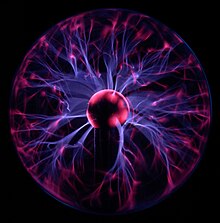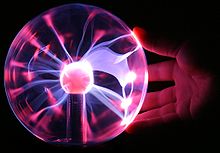Plasma lamp
A plasma lamp is a dielectric barrier discharge physical toy that was especially popular in the 1980s. It was invented by Nikola Tesla in 1892 and was used to study plasma . In 1894, Tesla obtained a patent on his invention.
Plasma lamps were made famous by Bill Parker and the Museum Exploratorium, as well as by the ARD science program Kopfball , which until October 2003 had a plasma ball (the “headball”) as a prize. Tesla called his invention " noble gas -Entladungsröhre" ( "Inert Gas Discharge Tube"). Plasma lamps are also called plasma balls, plasma globes, plasma balls or plasma spheres. They come in different shapes, for example a cylinder.
function
Although there are countless variations, the principle remains the same. A plasma lamp is usually a clear glass ball filled with a mixture of argon , neon, and nitrogen at low pressure. It is operated with an alternating voltage of approx. 20 kHz and a few kilovolts , which is generated in the base of the lamp by a special transformer for high frequencies with an oscillator circuit . A small ball in the center serves as an electrode . The counter electrode forms the environment connected via the power grid.
When the current is switched on, the gas is ionized and the free charge carriers are accelerated in the radially aligned electrical field . The lighter electrons quickly receive enough energy so that they generate additional charge carrier pairs through impact ionization . By impact excitation and recombination , the characteristic of the filling gas lights, see arises glow .
The constriction of the discharge to filaments (from the Latin filum "thread, string, fiber") is based on the following instability: Different space charges of positive ions lead to a corresponding concentration of electrons and thus the electrical current density and impact ionization, which intensifies the original differences. The filaments heat up slightly and rise by convection . By charging and reloading at the rate of the alternating voltage (see capacitor ), the glass ball limits the current intensity and distributes the current over the surface - if the ball were electrically conductive, the entire current would be concentrated on just one filament , without limitation, an arc would occur.
The current occurs as a dielectric displacement current both in the glass and in the ambient air . Conducting objects in the vicinity or on the sphere conduct and concentrate this current. B. his hand on the glass, the discharge is stronger from the contact surfaces. The current is partly conducted through the skin to the earth, but this can not be felt because of the skin effect . Electronic devices such as touchpads in laptops , portable music players, radio receivers and similar devices can be disturbed in their function in the vicinity of the lamp. LEDs and gas discharge lamps such as fluorescent lamps and neon lamps can be stimulated to glow. The glass should be UV-tight, otherwise the radiation will damage the eyes and generate ozone in the surrounding air .
In the 1980s, the circuit was used from the line deflection of a television with a picture tube ; therefore the device could be manufactured inexpensively from mass-produced parts.
variants
There are also so-called plasma disks (see also Planon ), in which not a glass ball, but a flat surface provided with phosphorus in a flat glass shows clearly visible flashes. You can see this for example in the Star Trek - feature films and - television series in the alcove of the Borg (greenish glowing plasma disc above the Borg drone).
Another variant is the so-called plasma tube. Here the lighting is generated in a cylindrical body. For medical purposes, this is known as Violet Wand .
The world's largest plasma ball with a diameter of one meter is located in the Swiss Science Center Technorama in Winterthur , Switzerland .


